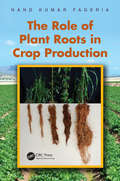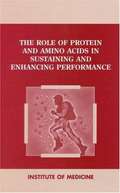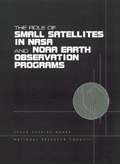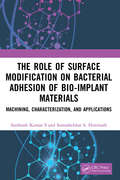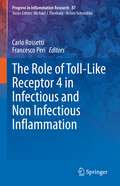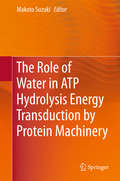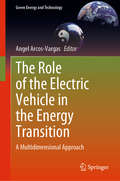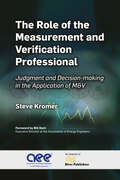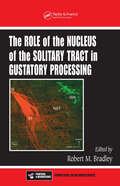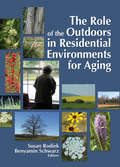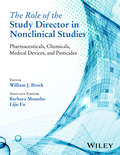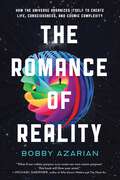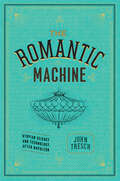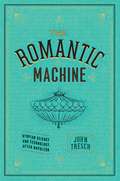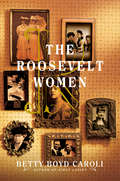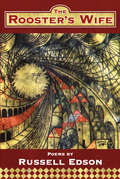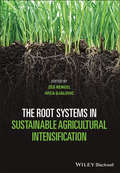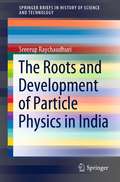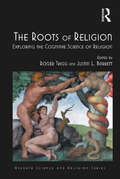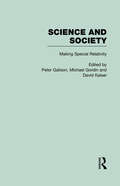- Table View
- List View
The Role of Plant Roots in Crop Production
by Nand Kumar FageriaThe Role of Plant Roots in Crop Production presents the state of knowledge on environmental factors in root growth and development and their effect on the improvement of the yield of annual crops. This book addresses the role of roots in crop production and includes references to numerous annual crops. In addition, it brings together the issues and
The Role of Protein and Amino Acids in Sustaining and Enhancing Performance
by Institute of MedicineIt is a commonly held belief that athletes, particularly body builders, have greater requirements for dietary protein than sedentary individuals. However, the evidence in support of this contention is controversial. This book is the latest in a series of publications designed to inform both civilian and military scientists and personnel about issues related to nutrition and military service.Among the many other stressors they experience, soldiers face unique nutritional demands during combat. Of particular concern is the role that dietary protein might play in controlling muscle mass and strength, response to injury and infection, and cognitive performance. The first part of the book contains the committee's summary of the workshop, responses to the Army's questions, conclusions, and recommendations. The remainder of the book contains papers contributed by speakers at the workshop on such topics as, the effects of aging and hormones on regulation of muscle mass and function, alterations in protein metabolism due to the stress of injury or infection, the role of individual amino acids, the components of proteins, as neurotransmitters, hormones, and modulators of various physiological processes, and the efficacy and safety considerations associated with dietary supplements aimed at enhancing performance.
The Role of Science in Solving the Earth's Emerging Water Problems
by M. SacklerThe National Academies Press (NAP)--publisher for the National Academies--publishes more than 200 books a year offering the most authoritative views, definitive information, and groundbreaking recommendations on a wide range of topics in science, engineering, and health. Our books are unique in that they are authored by the nation's leading experts in every scientific field.
The Role of Small Satellites in NASA and NOAA Earth Observation Programs
by National Research CouncilThe National Academies Press (NAP)--publisher for the National Academies--publishes more than 200 books a year offering the most authoritative views, definitive information, and groundbreaking recommendations on a wide range of topics in science, engineering, and health. Our books are unique in that they are authored by the nation's leading experts in every scientific field.
The Role of Surface Modification on Bacterial Adhesion of Bio-implant Materials: Machining, Characterization, and Applications
by Somashekhar S. Hiremath Santhosh Kumar S.The Role of Surface Modification on Bacterial Adhesion of Bio-implant Materials: Machining, Characterization, and Applications, explores the relationship between the surface roughness of artificial implants used for hard tissue replacement and their bacterial adhesion. It summarizes the reason for the failure of implants, the mechanisms of bacterial formation on implant surfaces, and the fundamental and established methods of implant surface modification techniques. It provides readers with an organized and rational representation about implant manufacturing and mechanical surface modification. It also explores the use of developed unidirectional abrasive flow finishing processes to finish biomaterials at the nano-level. It is an invaluable guide for academics, graduate students, biomaterial scientists, and manufacturing engineers researching implants, related infections, and implant manufacturing. Key Features: Explores implant related infections Discusses surface modification techniques Contains information on the mechanical finishing processes and complete guide on developed cutting edge unidirectional abrasive flow finishing technology
The Role of Technology in Distance Education (Routledge Revivals)
by Tony BatesThis book, first published in 1984, provides a comprehensive review of the range of technology that was being used in distance education. Technological developments in word processing, video-disc and viewdata as well as computer-based learning had revolutionised the potential for distance education. These developments required the role of more ’conventional’ distance learning media, such as broadcasting, tuition and text, to be reassessed. This book, written by international experts in the field, explored the state of the art at the time, and also provided their ideas on how future developments were likely to evolve. This book is ideal for those studying education and communications.
The Role of Toll-Like Receptor 4 in Infectious and Non Infectious Inflammation (Progress in Inflammation Research #87)
by Carlo Rossetti Francesco PeriTLR4 is one of the most important innate immunity receptors, its function mainly consisting in the activation of inflammatory pathways in response to stimulation by Pathogen-Associated Molecular Patterns (PAMPs) and Damage Associated Molecular Pattern molecules (DAMPs). This volume critically reviews the different types of TLR4 activators and inhibitors, discusses the role of molecular aggregates in agonism/antagonism as well as the pivotal role of the CD14 receptor in the modulation of TLR4 signal and the molecular details and actors of the intracellular cascade. The book presents the role of TLR4 in several pathologies, such as sepsis and septic shock caused by receptor activation by gram-negative bacterial lipopolysaccharide (LPS), in neurodegenerative and neurological diseases such as Parkinson and Alzheimer’s diseases, and Amyotrophic Lateral Sclerosis (ALS). It reviews the role of TLR4 in neural stem cell-mediated neurogenesis and neuroinflammation and in Human Induced Pluripotent Stem Cells and Cerebral Organoids and discusses the emerging role of micro-RNA (miRNA) regulation by TLR4.
The Role of Topology in Materials (Springer Series In Solid-state Sciences Ser. #189)
by Avadh Saxena Sanju GuptaThis book presents the most important advances in the class of topological materials and discusses the topological characterization, modeling and metrology of materials. Further, it addresses currently emerging characterization techniques such as optical and acoustic, vibrational spectroscopy (Brillouin, infrared, Raman), electronic, magnetic, fluorescence correlation imaging, laser lithography, small angle X-ray and neutron scattering and other techniques, including site-selective nanoprobes. The book analyzes the topological aspects to identify and quantify these effects in terms of topology metrics. The topological materials are ubiquitous and range from (i) de novo nanoscale allotropes of carbons in various forms such as nanotubes, nanorings, nanohorns, nanowalls, peapods, graphene, etc. to (ii) metallo-organic frameworks, (iii) helical gold nanotubes, (iv) Möbius conjugated polymers, (v) block co-polymers, (vi) supramolecular assemblies, to (vii) a variety of biological and soft-matter systems, e.g. foams and cellular materials, vesicles of different shapes and genera, biomimetic membranes, and filaments, (viii) topological insulators and topological superconductors, (ix) a variety of Dirac materials including Dirac and Weyl semimetals, as well as (x) knots and network structures. Topological databases and algorithms to model such materials have been also established in this book. In order to understand and properly characterize these important emergent materials, it is necessary to go far beyond the traditional paradigm of microscopic structure–property–function relationships to a paradigm that explicitly incorporates topological aspects from the outset to characterize and/or predict the physical properties and currently untapped functionalities of these advanced materials. Simulation and modeling tools including quantum chemistry, molecular dynamics, 3D visualization and tomography are also indispensable. These concepts have found applications in condensed matter physics, materials science and engineering, physical chemistry and biophysics, and the various topics covered in the book have potential applications in connection with novel synthesis techniques, sensing and catalysis. As such, the book offers a unique resource for graduate students and researchers alike.
The Role of Water in ATP Hydrolysis Energy Transduction by Protein Machinery
by Makoto SuzukiThis book introduces recent progress in biological energetics from ATP hydrolysis to molecular machineries. The role of water is now recognized to be essential in biological molecular energetics. Although energetics is a rather distant field to many biologists, any working models for protein machineries such as protein motors, transporters, and other enzymes must be consistent with their energetics. Therefore, the book is intended to help scientists build systematic models of biomolecular functions based on three categories: (1) ATP hydrolysis reactions including ionic hydration and protonation–deprotonation of biomolecules, (2) protein–ligand/protein–protein interactions including hydration–dehydration processes, and (3) functioning mechanisms of protein machineries based on water functions.
The Role of the Chemical Sciences in Finding Alternatives to Critical Resources
by National Research Council Steve Olson Chemical Sciences Roundtable Division on Earth and Life Studies Tina Masciangioli Board on Chemical Sciences and Technology Douglas FriedmanThe Chemical Sciences Roundtable (CSR) was established in 1997 by the National Research Council (NRC). It provides a science oriented apolitical forum for leaders in the chemical sciences to discuss chemistry-related issues affecting government, industry, and universities. Organized by the National Research Council's Board on Chemical Sciences and Technology, the CSR aims to strengthen the chemical sciences by fostering communication among the people and organizations - spanning industry, government, universities, and professional associations - involved with the chemical enterprise. One way it does this is by organizing workshops that address issues in chemical science and technology that require national attention. In September 2011, the CSR organized a workshop on the topic, "The Role of Chemical Sciences in Finding Alternatives to Critical Resources." The one-and-a-half-day workshop addressed key topics, including the economic and political matrix, the history of societal responses to key mineral and material shortages, the applications for and properties of existing minerals and materials, and the chemistry of possible replacements. The workshop featured several presentations highlighting the importance of critical nonfuel mineral and material resources in history, catalysis, agriculture, and electronic, magnetic, and optical applications. The Role of the Chemical Sciences in Finding Alternatives to Critical Resources: A Workshop Summary explains the presentations and discussions that took place at the workshop. In accordance with the policies of the NRC, the workshop did not attempt to establish any conclusions or recommendations about needs and future directions, focusing instead on issues identified by the speakers.
The Role of the Chemist in Automotive Design
by H. K. PhlegmFrom the development of polymers that make cars lighter to fuels that make them run cleaner, the chemist‘s role in the automotive industry has evolved to be one that is more outside the laboratory than in it. Drawing on the author‘s 20 years of experience in vehicle design and laboratory experience, The Role of the Chemist in Automotive
The Role of the Electric Vehicle in the Energy Transition: A Multidimensional Approach (Green Energy and Technology)
by Angel Arcos-VargasThis book explores the part that electric vehicles can play in reducing carbon dioxide emissions. Further, it explains the impact of public support, technological advances, lower costs and better battery performance in making electric vehicles a viable alternative. The book begins by analyzing the international context of electric vehicles and how they are being developed in different countries, and by offering a forecast of the electricity demand they may create. It then discusses technological innovations in electric vehicle recharging systems. The book is concerned not only with the economic potential of electric vehicles, but also with environmental aspects; consequently, it examines the raw materials supply chain and performs a lifecycle assessment. The book concludes with a chapter on alternative energies in transport, which may also help to facilitate the energy transition. Given its scope, the book offers a valuable resource for researchers, graduate students, policymakers and industry professionals interested in the energy transition and transport.
The Role of the Measurement and Verification Professional: Judgment and Decision-making in the Application of M&V (River Publishers Series in Energy Management)
by Steve KromerMeasurement and verification (M&V) is the accounting system for energy management. Implementing M&V as a professional requires both a broad understanding of concepts and contexts and an awareness of the fundamental tools used in estimating impacts of energy management. This book will assist those seeking to become M&V professionals by establishing the framework within which to conduct successful M&V. It does this by:Laying out the fundamental concepts underpinning M&V methods. A full understanding of the strengths and weaknesses of the fundamental methods allows the professional to communicate effectively.Reviewing the most common M&V guidelines and protocols. Many people enter the world of M&V through the various guidelines that attempt to standardize M&V methods. In this book you will learn about how these documents are aligned, and how and why they differ.Providing a list of the most common technical issues and areas requiring judgement that arise in every M&V project. Many of the activities of M&V involve technical tasks and analysis. Much of the core content of these tasks is developed fully in texts related to energy engineering. In this book you will learn how to incorporate energy engineering concepts into your M&V projects. Being a professional means making informed and sound decisions using good judgement. Being a successful M&V professional means communicating these decisions and judgements throughout the M&V process. This book is intended to expose the typical challenges faced in M&V and provide the tools for the M&V professional to conduct successful M&V now and into the future.M&V has often been defined as an art and a science. The art of M&V is expressed through the judgements that the M&V professional makes during an M&V project. The science of M&V is within the domain of those aspects that can be measured, quantified and reported. While the technical tasks within M&V are important, the most important task of the M&V professional is to establish and maintain clear and consistent communication among all parties throughout the M&V process.
The Role of the Nucleus of the Solitary Tract in Gustatory Processing
by Robert M. BradleyProviding an essential brainstem relay for three cranial nerves, the NST coordinates highly complex sensory information. While other functions of the NST have received attention, its role in gustatory processing has received little. The first reference devoted exclusively to gustatory processing, The Role of the Nucleus of the Solitary Tract in Gus
The Role of the Outdoors in Residential Environments for Aging
by Susan RodiekDiscover the physical and mental benefits of outdoor spaces for the elderlyThe Role of the Outdoors in Residential Environments for Aging presents new insights on the positive role nature and the outdoors can play in the lives of older adults, whether they live in the community, in an assisted-living environment, or in a skilled nursing
The Role of the Study Director in Nonclinical Studies
by William J. Brock Barbara Mounho Lijie FuA single-source reference with a broad and holistic overview of nonclinical studies, this book offers critical training material and describes regulations of nonclinical testing through guidelines, models, case studies, practical examples, and worldwide perspectives. The book:Provides a complete overview of nonclinical study organization, conduct, and reporting and describes the roles and responsibilities of a Study Director to manage an effective studyCovers regulatory and scientific concepts, including international testing and Good Laboratory Practice (GLP), compliance with guidelines, and animal modelsFeatures a concluding chapter that compiles case studies / lessons learned from those that have served as a Study Director for many yearsAddresses the entire spectrum of nonclinical testing, making it applicable to those in the government, laboratories and those actively involved in in all sectors of industry
The Romance of Reality: How the Universe Organizes Itself to Create Life, Consciousness, and Cosmic Complexity
by Bobby AzarianWhy do we exist? For centuries, this question was the sole province of religion and philosophy. But now science is ready to take a seat at the table. According to the prevailing scientific paradigm, the universe tends toward randomness; it functions according to laws without purpose, and the emergence of life is an accident devoid of meaning. But this bleak interpretation of nature is currently being challenged by cutting-edge findings at the intersection of physics, biology, neuroscience, and information theory—generally referred to as &“complexity science.&” Thanks to a new understanding of evolution, as well as recent advances in our understanding of the phenomenon known as emergence, a new cosmic narrative is taking shape: Nature&’s simplest &“parts&” come together to form ever-greater &“wholes&” in a process that has no end in sight. In The Romance of Reality, cognitive neuroscientist Bobby Azarian explains the science behind this new view of reality and explores what it means for all of us. In engaging, accessible prose, Azarian outlines the fundamental misunderstanding of thermodynamics at the heart of the old assumptions about the universe&’s evolution, and shows us the evidence that suggests that the universe is a &“self-organizing&” system, one that is moving toward increasing complexity and awareness. Cosmologist and science communicator Carl Sagan once said of humanity that &“we are a way for the cosmos to know itself.&” The Romance of Reality shows that this poetic statement in fact rests on a scientific foundation and gives us a new way to know the cosmos, along with a riveting vision of life that imbues existence with meaning—nothing supernatural required.
The Romantic Machine: Utopian Science and Technology After Napoleon
by John TreschIn the years immediately following Napoleon’s defeat, French thinkers in all fields set their minds to the problem of how to recover from the long upheavals that had been set into motion by the French Revolution. Many challenged the Enlightenment’s emphasis on mechanics and questioned the rising power of machines, seeking a return to the organic unity of an earlier age and triggering the artistic and philosophical movement of romanticism. Previous scholars have viewed romanticism and industrialization in opposition, but in this groundbreaking volume John Tresch reveals how thoroughly entwined science and the arts were in early nineteenth-century France and how they worked together to unite a fractured society. Focusing on a set of celebrated technologies, including steam engines, electromagnetic and geophysical instruments, early photography, and mass-scale printing, Tresch looks at how new conceptions of energy, instrumentality, and association fueled such diverse developments as fantastic literature, popular astronomy, grand opera, positivism, utopian socialism, and the Revolution of 1848. He shows that those who attempted to fuse organicism and mechanism in various ways, including Alexander von Humboldt and Auguste Comte, charted a road not taken that resonates today. Essential reading for historians of science, intellectual and cultural historians of Europe, and literary and art historians, The Romantic Machine is poised to profoundly alter our understanding of the scientific and cultural landscape of the early nineteenth century.
The Romantic Machine: Utopian Science and Technology after Napolean
by John TreschIn the years immediately following Napoleon’s defeat, French thinkers in all fields set their minds to the problem of how to recover from the long upheavals that had been set into motion by the French Revolution. Many challenged the Enlightenment’s emphasis on mechanics and questioned the rising power of machines, seeking a return to the organic unity of an earlier age and triggering the artistic and philosophical movement of romanticism. Previous scholars have viewed romanticism and industrialization in opposition, but in this groundbreaking volume John Tresch reveals how thoroughly entwined science and the arts were in early nineteenth-century France and how they worked together to unite a fractured society. Focusing on a set of celebrated technologies, including steam engines, electromagnetic and geophysical instruments, early photography, and mass-scale printing, Tresch looks at how new conceptions of energy, instrumentality, and association fueled such diverse developments as fantastic literature, popular astronomy, grand opera, positivism, utopian socialism, and the Revolution of 1848. He shows that those who attempted to fuse organicism and mechanism in various ways, including Alexander von Humboldt and Auguste Comte, charted a road not taken that resonates today. Essential reading for historians of science, intellectual and cultural historians of Europe, and literary and art historians, The Romantic Machine is poised to profoundly alter our understanding of the scientific and cultural landscape of the early nineteenth century.
The Roosevelt Women: A Portrait In Five Generations
by Betty Boyd CaroliThe Roosevelt name conjures up images of powerful Presidents and dashing men of high society. But few people know much about the extraordinary network of women that held the Roosevelt clan together through war, scandal, and disease. In The Roosevelt Women, Betty Boyd Caroli weaves together stories culled from a rich store of letters, memoirs, and interviews to chronicle nine extraordinary Roosevelt women across a century and a half of turbulent history.She examines the Roosevelt women as mothers, daughters, wives, and, beyond that, as world travelers, authors, campaigners, and socialites-in short, as themselves. She reveals how they demonstrated the energy and intellectual curiosity that defined their famous family, as well as the roles they played in the intrigues, scandals, and accomplishments that were hallmarks of the Roosevelt clan. From the much maligned Sara Delano (who sired Franklin and by turns terrified and supported Eleanor) to Theodore's irrepressible daughter, Alice (”I can either rule the country or control Alice,” Teddy once said) to the beloved Bamie, who was the only mother Alice ever knew, and the model of everything she never was in life, to the exceptionally beautiful but ultimately overwhelmed Mittie, Theodore's mother, The Roosevelt Women is an intricate portrait of bold and talented women, a grand tale of both unbearable tragedies and triumphant achievements.
The Rooster's Wife (American Poets Continuum #Vol. 90)
by Russell EdsonFor the past 40 years, Russell Edson has been producing a body of work unique in its perspective and singular in its approach. He is, arguably, America’s most distinguished writer of prose poems. Here are contorted Darwinian narratives of apes and monkeys exhibiting absurdly human behavior, along with his usual menagerie of elephants, horses, chickens, roosters, dogs, mermaids and mice. Along with his trademark humor, The Rooster’s Wife finds Edson contemplating age, mortality and immortality as well.Of Memory and DistanceIt’s a scientific fact that anyone entering the distance will grow smaller as he proceeds. Eventually becoming so small he might only be found with a microscope, if indeed he is found at all. But there is a vanishing point, where anyone having entered the distance must disappear entirely without hope of his ever returning, leaving only the memory of his ever having been. But then there is fiction, so that one can never really be sure if one is remembering someone who vanished into the distance, or simply who had been made of paper and ink . . .Russell Edson has been called a surrealist comic genius, a magician of metaphor and imagination. He is all of these, and a philosophical poet whose zany expeditions into the twisted labyrinths of logic resemble Lewis Carroll’s adventures through the wonderlands of paradox and illusion. Perhaps that is why even people who do not read significant amounts of contemporary poetry can immediately appreciate the playful accessibility of Russell Edson’s writing. What he pulls out of the hat of the subconscious is always unpredictable, immediate and surprising.Russell Edson’s books include The Very Thing That Happens (1964); The Childhood of an Equestrian (1973); The Tunnel: Selected Poems (1994); and The House of Sara Loo (Rain Taxi Chapbook Series, 2002). He lives in Darien, Connecticut.
The Root Systems in Sustainable Agricultural Intensification
by Zed Rengel Ivica DjalovicExplore an in-depth and insightful collection of resources discussing various aspects of root structure and function in intensive agricultural systems The Root Systems in Sustainable Agricultural Intensification delivers a comprehensive treatment of state-of-the-art concepts in the theoretical and practical aspects of agricultural management to enhance root system architecture and function. The book emphasizes the agricultural measures that enhance root capacity to develop and function under a range of water and nutrient regimes to maximize food, feed, and fibre production, as well as minimize undesirable water and nutrient losses to the environment. This reference includes resources that discuss a variety of soil, plant, agronomy, farming system, breeding, molecular and modelling aspects to the subject. It also discusses strategies and mechanisms that underpin increased water- and nutrient-use efficiency and combines consideration of natural and agricultural systems to show the continuity of traits and mechanisms. Finally, the book explores issues related to the global economy as well as widespread social issues that arise from, or are underpinned by, agricultural intensification. Readers will also benefit from the inclusion of: A thorough introduction to sustainable intensification, including its meaning, the need for the technology, components, and the role of root systems Exploration of the dynamics of root systems in crop and pasture genotypes over the last 100 years Discussion of the interplay between root structure and function with soil microbiome in enhancing efficiency of nitrogen and phosphorus acquisition Evaluation of water uptake in drying soil, including balancing supply and demand Perfect for agronomists, horticulturalists, plant and soil scientists, breeders, and soil microbiologists, The Root Systems in Sustainable Agricultural Intensification will also earn a place in the libraries of advanced undergraduate and postgraduate students in this field who seek a one-stop reference in the area of root structure and function.
The Roots and Development of Particle Physics in India (SpringerBriefs in History of Science and Technology)
by Sreerup RaychaudhuriThis book narrates the history of the initiation and development of elementary particle physics in India and by Indians, focusing on the first half of the twentieth century. The thread is taken up with the introduction of Western science into India in the previous century. The contents are a mixture of science and biographies, interspersed with anecdotes and reflections on the historical and societal connections. The style is generally non-technical, with any technical issues explained and interwoven into the narrative. This book is of interest to scientists, to people with interest in science and the history of science, students curious about the initiation of science in the Indian context and about the famous Indian scientists, as well as administrators who wish to understand the roots of current Indian science, especially in the context of particle physics.
The Roots of Religion: Exploring the Cognitive Science of Religion (Routledge Science and Religion Series)
by Roger Trigg And Justin L. BarrettThe cognitive science of religion is a new discipline that looks at the roots of religious belief in the cognitive architecture of the human mind. The Roots of Religion deals with the philosophical and theological implications of the cognitive science of religion which grounds religious belief in human cognitive structures: religious belief is ’natural’, in a way that even scientific thought is not. Does this new discipline support religious belief, undermine it, or is it, despite many claims, perhaps eventually neutral? This subject is of immense importance, particularly given the rise of the ’new atheism’. Philosophers and theologians from North America, UK and Australia, explore the alleged conflict between truth claims and examine the roots of religion in human nature. Is it less ’natural’ to be an atheist than to believe in God, or gods? On the other hand, if we can explain theism psychologically, have we explained it away. Can it still claim any truth? This book debates these and related issues.
The Roots of Special Relativity: Science and Society
by Peter Galison David Kaiser Michael GordinModern science has changed every aspect of life in ways that cannot be compared to developments of previous eras. This four-volume set presents key developments within modern physical science and the effects of these discoveries on modern global life. The first two volumes explore the history of the concept of relativity, the cultural roots of science, the concept of time and gravity before, during, and after Einstein's theory, and the cultural reception of relativity. Volume 3 explores the impact of modern science upon global politics and the creation of a new kind of war, and Volume 4 details the old and new efforts surrounding the elucidation of the quantum world, as well as the cultural impact of particle physics. This reprint collection pools the best scholarship available, collected from a large array of difficult to acquire books, journals, and pamphlets. Each volume begins with an introductory essay, written by one of the top scholars in the history of science. Students and scholars of modern culture, science, and society will find these volumes a veritable research gold mine.
